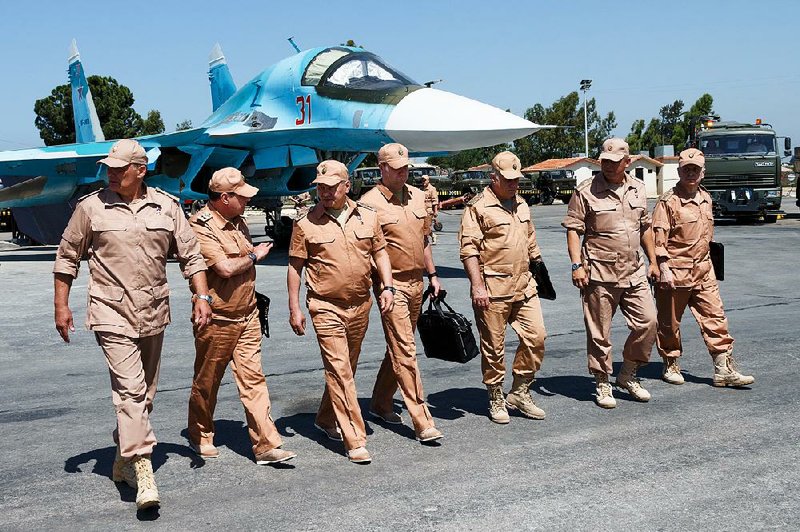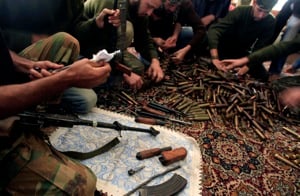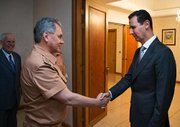BEIRUT -- Militants captured two villages from Syrian government forces and their allies in the northern province of Aleppo after days of heavy fighting left scores of fighters dead, Syrian activists said Saturday.
The Britain-based Syrian Observatory for Human Rights said the four-day offensive by different militant groups, including the al-Qaida-affiliated Nusra Front, killed 86 troops and pro-government gunmen, including 25 members of Lebanon's Hezbollah group.
The Observatory and the Local Coordination Committees, both of which monitor the conflict through networks of activists, said militants now control the villages of Zeitan and Khalsa, south of Aleppo city.
The Nusra Front and its allies have begun several offensives south of Aleppo in recent months, inflicting heavy casualties among pro-government forces. Government forces, meanwhile, have closed in on rebel-held parts of the city, which have been under daily bombardment.
"The situation is very good," a Nusra Front fighter in southern Aleppo told The Associated Press by telephone. The fighter, who goes by the name Abu al-Hassan al-Muhajer, confirmed that the militants have captured the villages.
Hezbollah issued a statement Saturday in Beirut saying it lost a number of "martyrs" in "direct and fierce confrontations with terrorist organizations." The group denied Arab media reports that said Hezbollah fighters were killed in clashes with Syrian President Bashar Assad's forces and struck by Syrian government warplanes, saying its relations with the Syrian army and other allies are "strong."
Hezbollah has sent thousands of fighters to Syria to back Assad's forces and has played a key role in a string of government victories.
In Aleppo city, shelling killed seven people and wounded more than a dozen in the predominantly Kurdish neighborhood of Sheikh Maqsoud. The area is under the control of the main Kurdish militia, the People's Protection Units, which has clashed with Syrian insurgents as well as the Islamic State militant group.
Elsewhere, U.S. defense officials condemned Russian airstrikes last week on a base used by U.S.-backed Syrian fighters.
Images released Friday by the Syrian Observatory for Human Rights, a group that has monitored the conflict since its start, reportedly show the aftermath of the strikes on the base at At-Tanf, a town near the borders of Iraq, Syria and Jordan.
One of the pictures portrays what appears to be the tail section of an RBK-500 cluster munition, a type of bomb seen being used by the Russian air force since the start of its mission in Syria in September. According to the Syrian Observatory, the strikes killed two people and injured four.
The Pentagon said it held a videoconference Saturday with the Russian military to discuss the airstrikes.
"Russia's continued strikes at At-Tanf, even after U.S. attempts to inform Russian forces through proper channels of ongoing coalition air support to the counter-ISIL forces, created safety concerns for U.S. and coalition forces," it said in a statement, using an alternative acronym for the Islamic State.
The videoconference was held as part of bilateral communications channels intended to prevent encounters in the crowded skies over Syria.
The United States has criticized the Russian campaign in Syria for propping up Assad's forces and not going after terrorist groups such as the Islamic State and the Nusra Front. Recently, however, as Assad's forces have made gains toward the Islamic State capital in Raqqa and around the city of Palmyra, Russian helicopter gunships and aircraft have been hitting the extremist group more frequently.
It is unclear what the U.S.-backed Syrian forces in that region are doing now. In March, U.S. rocket artillery based in Jordan was used to assist Syrian fighters near At-Tanf who were fighting to take Islamic State positions south of Palmyra.
Russia's Defense Minister Sergei Shoigu, meanwhile, visited Syria on Saturday to meet with Assad in Damascus and inspect the Russian air base there.
Since September, Russia's air campaign in Syria has helped Assad's forces win back some ground. Russian President Vladimir Putin pulled back some of Russia's warplanes in March in what he described as a move to help encourage peace talks, but the military has maintained a strong presence at Hemeimeem air base in Latakia.
Shoigu and Assad's talks focused on cooperation between the two militaries and "some aspects of cooperation in the fight against terrorist groups," the Russian Defense Ministry said. It said Shoigu held talks with Assad on orders from Putin.
The visit came a day after Putin suggested that some in the Syrian opposition could join the Cabinet to help advance the stalled peace process.
At Hemeimeem, Shoigu met with pilots and inspected their quarters, according to the Defense Ministry's spokesman, Maj. Gen. Igor Konashenkov.
Five years of conflict have killed more than 250,000 people in Syria.
A U.S.- and Russian-brokered cease-fire that began Feb. 27 has helped reduce hostilities, but fierce fighting has continued in many areas, particularly around Aleppo.
A Section on 06/19/2016


